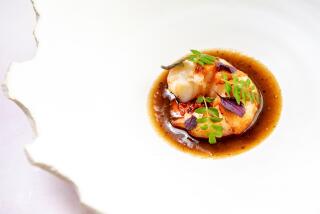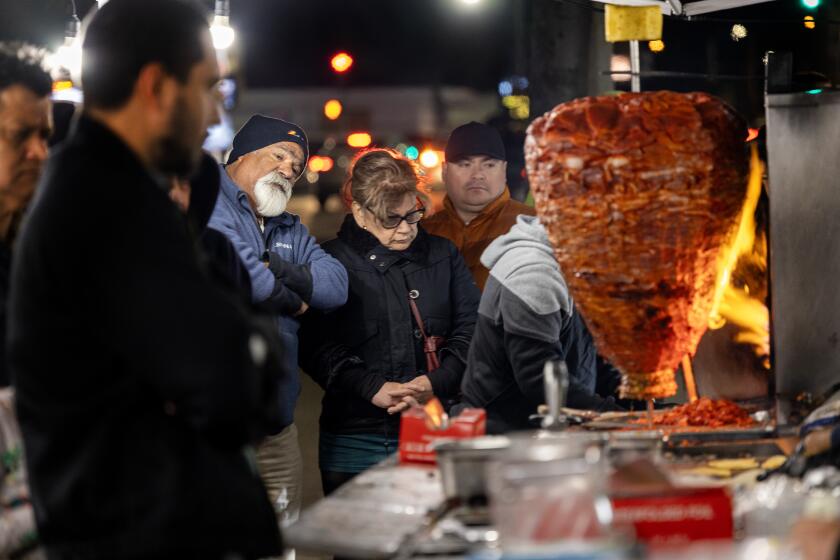Tastemaker for the Masses : She Knows We Want Shrimp Before We Know We Want Shrimp. And She <i> Knows</i> We Want Shrimp.
THESE ARE TREACHEROUS times. The men and women who attend the brainstorming session have taken a vow of secrecy. The printed agenda is for their eyes only. The results of the research project they’ve just completed will not be divulged outside this anonymous conference room, in one of the faceless office buildings that line Jefferson Boulevard in West Los Angeles.
At stake? The loyalty of the midscale American diner--the customer who dines out but not up, who often reads the menu from right to left. Thanks to a weak economy and strong competitors, it’s a pitched battle; there are not enough customers to go around. The nine people in this room work either for the Sizzler chain or for its advertising agency, BBDO. Their mission is to protect Sizzler’s position as the most profitable player in the “casual dining room” segment of the market.
With more than $845 million in sales in fiscal 1989, the 646-unit Sizzler chain is where middle America eats most of its restaurant meals: As many as 7,000 people visit each one of the chain’s 135 California outlets in any given week. But Sizzler’s sales over the past eight months, along with the rest of the industry’s, have eroded a bit as its core customers--working singles and families in their 20s and early 30s--have chosen to ease the economic pinch by eating cheaper or eating at home.
Mike Minchin, executive vice president of Collins Foods (which runs Sizzler as well as 209 Kentucky Fried Chicken franchises on the West Coast), says that Sizzler’s most formidable enemy in the past year was the adjustable-rate mortgage. When rates go up, people cut back. The weekday business-lunch crowd saves by eating at McDonald’s or Jack in the Box, and the families who come in as a treat on the weekends opt for home cooking. As for the sudden proliferation of Souplantations and Soup Expresses, Minchin is used to a crowded field that includes Bob’s Big Boy and Marie Callender’s. “Anyone who puts food in somebody’s stomach is keeping us from putting food in somebody’s stomach,” he says.
To maintain its place at the head of the pack, Sizzler must make its food irresistible. The purpose of the meeting, one of the two major strategy sessions held each year, is to decide how best to tempt the American palate. Secrecy is essential: Today’s good idea, seasoned with indiscretion, can become tomorrow’s success for the competition.
The gustatory conscience of the chain, 36-year-old Stacey James, sits at the head of the table. Her formal title is director of menu development, but, practically speaking, she is Sizzler’s premier taste bud. A dish has to satisfy James to get out of the test kitchen, and she is not an easy mark.
In a year’s time, maybe 400 dishes will be suggested in a series of menu idea meetings. Most never get any further: Either they don’t sound good, are too hard to prepare in volume or don’t conform to the received wisdom, supported by extensive market research, that Sizzler should offer what BBDO account supervisor Jim Ward calls “good, substantial American food, similar to what you could do at home but with a twist that makes you want to go out and get it.”
James and Jim Scharf, director of field marketing, present the candidates that survive this meeting to Minchin, who decides which ones will run the gantlet of the product development process. Those that make it through James’ in-house tastings, the focus groups and the test-market trial runs may win a place on the Sizzler menu, from which they can be unceremoniously yanked if they don’t perform up to expectations. Only two or three of the year’s candidates will make it onto the regular rotation of about 80 items.
“It’s the myth of Sisyphus,” says James. “You push these rocks up the hill inch by inch, and a dish that makes it is one that rolled up to the top and stayed there instead of rolling back down.”
THE PROCESS BEGINS with the basic question: What do diners want?
James’ response is authoritative and enigmatic, as befits a woman who has spent the last five years attempting to define and satisfy desires. “It’s this line,” she says: “It’s got to be new but familiar. It’s got to be interesting but not off the wall.”
Huh?
The experts she has called together--Sizzler representatives from purchasing, advertising, marketing and the test kitchen, along with the three BBDO executives--understand the challenge. The typically schizophrenic Sizzler customer talks cholesterol out of one side of his mouth while he pops a fried shrimp into the other. Minchin loves to tell the story of the Encino doctor--”a heart specialist,” he crows--who explained that it was OK to eat a platter of fried food because he’d taken a run that morning. James may be the creator of Sizzler’s lemon herb chicken, a good-for-you skinless number flavored with herbs, but she also knows her way around a corn fritter.
Eighty percent of Sizzler’s sales come from its all-you-can-eat dishes--the wildly successful salad bar and America’s favorite crustaceous vice, the fried shrimp--and steak. Twenty rcent of the customers are less addicted and more selective, which means they might get bored and choose another restaurant. No one, in either camp, is what you’d call daring. The goal is to keep the faithful shrimpers happy while finding new items to interest, but not intimidate, the pickier eaters.
Essentially, Sizzler customers want food that tastes good but may not be good for them, prepared in ways that will surprise but not shock them. In the geopolitics of food service, it’s all a question of whether a dish is “pre-Melrose,” “Melrose courant ,” or “post-Melrose.” Pre-Melrose is so boring it doesn’t even deserve to be discovered; Melrose of the moment is too avant-garde, and post-Melrose runs the risk of being passe even to people who’ve never ventured onto the street. The trick is to grab a recipe just as a newer food phenom nudges it aside, but before it becomes the bell-bottom blue jeans of popular cuisine.
Take a particular beef dish, one of the first items on the afternoon’s agenda, which must go unnamed in the interest of national Sizzler security. Is it still hip?
“I had it last night,” Jim Scharf says. “That makes it hip.”
“I think, in terms of Melrose, it’s no longer hip,” says BBDO’s Ward, who dutifully lunched at the Marina del Rey Sizzler on his way over and has alerted James to a “bad bun-to-tuna ratio” on his grilled sandwich.
“I was on La Brea, not Melrose,” Scharf says.
“But La Brea is the new Melrose,” says Robin Adams, who runs the Sizzler test kitchen.
“Hey,” persists Ward, “we’re pushing Southwestern, and that was over last year.”
But James thinks the dish is a trifle old, recommends rejecting it, and moves on to a complicated steak preparation she likes even less.
The dish might work at what she calls a “white-tablecloth restaurant,” but an assembly-line kitchen would mangle it. Her much-beloved “Sizzkabobs,” skewers of steak, chicken and fish, met an untimely death three years ago because kitchen workers groused about how long it took to impale those chunks of protein. She gazes down the table, almost daring anyone to contradict her. No one does.
Chicken with pesto sauce dies undefended. “Nice, but I remind you that it would be green,” James says in a tone of voice that might be used to describe mildew. “Do Sizzler customers want to see something green ?” Apparently not. The dish gets a B-minus. It will not be mentioned again.
MOST MENU DEVELOPMENT executives (and all of Sizzler’s competitors have them) are food technicians--home economists or number crunchers. But Stacey James is the sensual exception, a “hands-on cook” who talks about food the way Erica Jong writes about sex.
James’ idea of a good time is to turn out a turkey dinner, complete with side dishes, for no reason except that she, her husband and son have to eat something for dinner. In this era of the quick culinary fix, she is one of the few people who can utter the words “I cooked for days” with a beatific smile.
Like the heroine of E. M. Forster’s “A Room With a View,” James discovered the meaning of life during a sojourn in Florence, Italy. After studying art history at the University of California, Santa Cruz, in the early 1970s, she moved to Los Angeles and worked at Sotheby’s auction house and a rare book dealer’s. She was dabbling in cooking on the side when a friend told her his mother needed a cook at her villa outside Florence.
“She hired me,” recalls James, “because she had lots of guests all the time from other parts of Europe, and museum people, so she wanted someone who could cook these nice little dinner parties and impress people.
“Meanwhile, during the day there was this old peasant woman who was the housekeeper who did all the cooking for the midday meal. She was 80 years old and had worked in that house for 50 years.” James’ saucer eyes grow to salad-plate size at the memory. “She was cooking very old-style stuff. It really changed the way I started thinking about food. When I came back, I pursued it. It just seemed like the way to eat.”
To eat, but not necessarily the way to live. James made pastries at Il Fornaio for a year, then spent another year as a sous- chef at Prego in Beverly Hills before the premium placed on uniformity started to get to her. “I was stuck in that restaurant mode where the goal is to make food taste exactly the way it tasted the night before,” she says, “and I was in danger of burning out.” She applied at a private club for a job that never materialized. A month later, she got a phone message asking her to send her resume to Sizzler headquarters.
“I thought it was a friend playing a joke,” she recalls. It turned out to be Minchin, who belonged to the club where James had applied and had heard about her from the chef there. It wasn’t the job she’d been looking for, but it did promise creative freedom.
Sizzler, although a formula restaurant, was known for its flexibility. (The chain’s profitability can be traced, James believes, to a “repositioning” in the early 1980s that recast Sizzler the Family Steak House as Sizzler--Steak, Salad, Seafood.) There was a certain corporate devotion to inventive ideas, and uniformity would be somebody else’s worry.
James decided to find out if her notion of good food would trickle down to the mass market.
IT WASN’T LONG before she started having shrimp nightmares.
Shrimp is coin of the realm for the mainstream dining public because it is a food that has the magical effect of making people feel special. It has an upscale gestalt. “Shrimp is extremely popular,” James says. “I am called upon to develop shrimp endlessly. “
She has constant shrimp anxiety. Can she come up with a recipe? Is there any ethnicity that Sizzler has yet to exploit?
Given the volume she’s dealing with, a mistake can be devastating. A single four-week special promotion of a three-shrimp platter--planned for March and limited to Southern California--will require 280,000 pounds of tiny cocktail shrimp.
And there’s never any guarantee, even on what would seem to be a low-risk venture. The American Sampler introduced last year looked like a shoo-in, since it combined fried shrimp, Cajun popcorn shrimp and New England-style boiled shrimp.
Unfortunately, no one considered the gap between East Coast work ethic and West Coast pleasure principle. The boiled shrimp were served in the shell, as is traditional in the land where people are used to overcoming nature’s hardships. But sybaritic Californians, whose greatest climatic challenge is to remember how to turn on the car windshield wipers, let it be known that they preferred their shrimp undressed.
“People here do not like to have to peel their own shrimp,” James says glumly. “They just said: ‘Phooey. We don’t want to have to do this.’ ” The dish didn’t last two weeks.
Usually, though, the development process ensures the success of the end product, and disappointments can be salvaged. James recently introduced her latest sea baby, a grilled barbecued shrimp with a sauce she invented that was “very smoky and mesquite-y with bacon in it and everything.”
The pre-release response was a dream, James says. “Everybody--unanimously--in all three focus groups, said, ‘We love this; where can we buy it?’ ”
The post-release response was deadly. “It didn’t do anything,” says James. “The name just wasn’t describing what it was. Pacific-Style Barbecued Shrimp. What’s that?” James pressed for a new marketing plan. The dish was renamed Mesquite Shrimp, slapped on a Southwestern Grill platter with steak and Santa Fe chicken and turned into a hit.
THE BALDWIN HILLS SIZZLER, a new 226-seat pastel prototype for Sizzlers to come, is one of James’ laboratories, an outlet she uses to try out new products. This Sizzler features a grand experiment--the Buffet Court, a maze of all-you-can-eat offerings designed to keep the chain’s more fickle customers coming back. The salad and tostada bar is still the centerpiece, but it’s surrounded by a dessert bar, a hot appetizer bar and a pizza and pasta bar.
James is particularly proud of the pizza. She couldn’t serve “what in Italy is considered a nighttime pizza”--a delicate, thin-crusted version--because “it would be limp after five minutes on the steam table.” She wanted to serve “an Italian daytime pizza, the kind with the thick crust that people in Italy buy at room temperature,” but she knew Americans wouldn’t pay good money for cold pizza. With a supplier, she worked up “a homemade-looking product” with a chewy crust that can stand up to sitting around, and the response in Baldwin Hills has been “terrific.”
She knows firsthand: Focus groups are nice, and sales figures are the bible, but James regularly visits Sizzlers around the country to make sure a dish isn’t dying of sloppy execution. She and her co-workers can launch a grilled tuna sandwich with confidence at a few select Sizzlers. But let one employee start serving broiled tuna that lacks those attractive grill marks, and the dish can fail, unless someone who knows right from wrong sees the goof in time. And James can’t afford to let a good idea succumb.
“I always keep thinking that it’s going to get easier next month,” she says. “But it doesn’t. I can show you a list of new products I’ve come up with, but OK, after those are out, then what are we going to do? What about next year? You always have to be thinking way out there. It never ends.”
AS THE MEETING drags on, and the M & Ms James supplies to jump-start the collective imagination disappear, as a debate about a stuffed chicken breast deteriorates into jokes about topless chicken, James reaches beyond Sizzler’s standard vocabulary for an idea. The group has already rejected duck, served any way at all, as too weird. But how about turkey?
“The turkey people have been knocking down my door,” she ventures, hope in her voice, perhaps thinking about the nice job she did on that turkey at home the week before. The news is greeted with a collective groan.
She perseveres. How about smoked turkey, which has everything going for it? It’s new, it’s fashionable but not cutting-edge, and it’s healthful.
The groans only get louder.
“If blackened food is post-Melrose, then turkey is still pre-Melrose,” says Jim Ward. “I think we’ve got to wait until it gets over that hill.”
The group settles on a less controversial topic. Perhaps there’s something they haven’t tried with--you know--a shrimp.
More to Read
Eat your way across L.A.
Get our weekly Tasting Notes newsletter for reviews, news and more.
You may occasionally receive promotional content from the Los Angeles Times.






